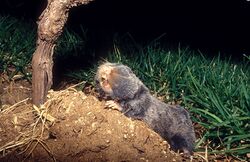Biology:Middle East blind mole-rat
| Middle East blind mole-rat | |
|---|---|

| |
| Scientific classification | |
| Domain: | Eukaryota |
| Kingdom: | Animalia |
| Phylum: | Chordata |
| Class: | Mammalia |
| Order: | Rodentia |
| Family: | Spalacidae |
| Genus: | Spalax |
| Species: | S. ehrenbergi
|
| Binomial name | |
| Spalax ehrenbergi (Nehring, 1898)
| |
| Synonyms | |
|
Nannospalax ehrenbergi | |
The Middle East blind mole-rat or Palestine mole-rat (Spalax ehrenbergi) (also known as Nannospalax ehrenbergi) is a species of rodent in the family Spalacidae.[2]
Description
The Middle East blind mole-rat weighs 100–200 grams (3.5–7.1 oz). It has light gray fur and four sharp teeth, two large teeth in the upper jaw and two smaller teeth in the lower jaw. It has a life span of up to 20 years and is notable for its adaptability to severe lack of oxygen. In Israel, the blind mole-rat is a major agricultural pest. It digs long tunnels up to 80 centimeters deep and stores onions and tubers in underground chambers.[3] The exceptional ecological adaptation strategies of the blind mole-rats can be seen in their different tongue morphologies, as evidenced by their tongue papillae. The tongue papillae differ between individuals in a species to adapt to different environmental regions with variant soil characteristics and food types.[4]
Distribution and habitat
Spalax ehrenbergi is found in Egypt, Iraq, Turkey and the Levant (Israel, Syria, Palestine, Jordan and Lebanon). The natural habitat of the mole is Mediterranean-type shrubbish vegetation, and it is threatened by habitat loss.
Possible cryptospecies
Recent cytogenetic studies have shown S. ehrenbergi in Israel may actually be a superspecies group containing several cryptic species with chromosome numbers 2n=52, 2n=54, 2n=58 and 2n=60.[5] Close to the 'border line' of the niche of each subspecies there is mating between individuals from different subspecies/different 2n chromosome number. Birth of fertile offspring implies that speciation of the subspecies has not been completed[citation needed].
Use in research
According to Israeli researchers at Haifa University, the Middle East blind mole-rat is the ultimate lab animal for researching cancer due to its extraordinary resistance to the disease.[3] In their publication [Manov et al., BMC Biology, 2013] interesting data on Spalax resistance to cancer have been documented:
-No spontaneous tumors have ever been noticed in blind mole rat, based on observing thousands of individuals along half a century.
-Inducing cancer with chemical carcinogens that lead to 100% of the expected tumors in mice and rats after 2–6 months, respectively, indicate an extraordinary cancer resistance of Spalax: Only 2 out of 12 animals, and old ones (>10 years old; Spalax can live ~>20 years; 5 times longer than its evolutionary relative, the rat) developed the expected tumor with one of the carcinogens and only after 18 and 30 months.
- Most intriguing, Spalax cells (fibroblasts), and only Spalax cells, when grown in co-culture with cancer cells from different species, including a wide range of human cancer cells, kill the cancer cells. This is also true when "feeding" the cancer cells with the medium that Spalax cells grew in. Identification of the secreted substance/s by Spalax fibroblasts and the component on cancer cells' membrane they interact with, that lead to the cancer cells' death can open a possibility for finding a general cure to cancer.
See also
- Wildlife of Israel
References
- ↑ Schlitter, D. 2004. Nannospalax ehrenbergi. 2006 IUCN Red List of Threatened Species.
- ↑ Musser, G. G. and Carleton, M. D. 2005. "Superfamily Muroidea". Pp. 894-1531 in Mammal Species of the World a Taxonomic and Geographic Reference. D. E. Wilson and D. M. Reeder eds. Johns Hopkins University Press, Baltimore
- ↑ 3.0 3.1 Better check that mole: Has an Israeli biologist found the key to curing cancer? Haaretz
- ↑ Kilinic, M., Erdogan, S., Ketani, S., Ketani, M. A. (2010). "Morphological Study by Scanning Electron Microscopy of the Lingual Papillae in the Middle East Blind Mole Rat (Spalax ehrenbergi, Nehring, 1898)". Journal of Veterinary Medicine 39: 509-515.
- ↑ Sözen, M et al., Some karyological records and a new chromosomal form for Spalax (Mammalia: Rodentia) in Turkey. Folia Zool. – 55(3): 247–256 (2006)
| Wikimedia Commons has media related to Nannospalax ehrenbergi. |
Wikidata ☰ Q13422405 entry



